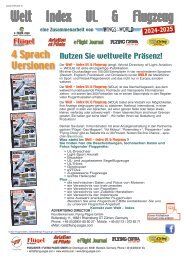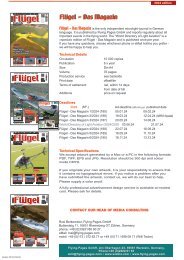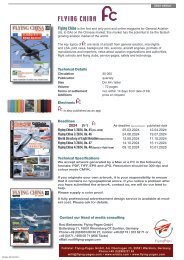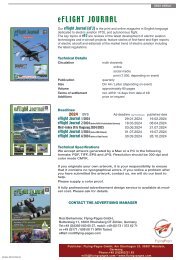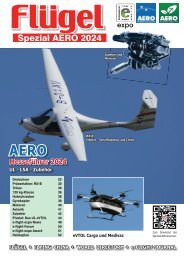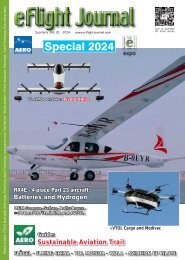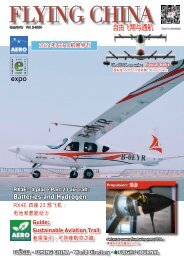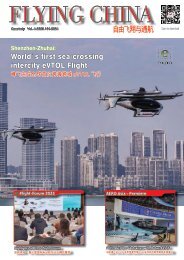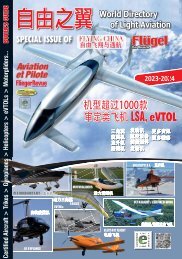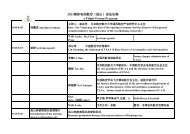You also want an ePaper? Increase the reach of your titles
YUMPU automatically turns print PDFs into web optimized ePapers that Google loves.
e Visions<br />
percent and could drop to zero when battery densities improve<br />
and renewable energy is used. Short distance <strong>flight</strong>s<br />
could be done fully electric sooner and reducing the noise<br />
and emissions in metropolitan areas dramatically.<br />
Technically the aircraft would be driven by two ducted fans,<br />
which will be driven by electric motors. As an energy source<br />
there will be batteries (mainly for takeoff) and a gas turbine<br />
that sits in the middle of the V-tail.<br />
For the question of why they use ducted fans, as there is<br />
no successful aircraft in history with this concept and Airbus<br />
just stopped it’s e-Fan project, Mike Friend a retired former<br />
Technical Director of Boeing and now Zunum consultant explains<br />
the reason, “ Zunum believes that ducted fans are the<br />
right answer for several reasons. The first is noise, as use<br />
of small airports close in to cities will require an airplane quiet<br />
enough not to raise objections from those living close to<br />
those airports. The second is the robust low speed static<br />
thrust generated by a ducted fan that will help the Zunum airplanes<br />
use short runways of 2,500 to 3,500 ft. Several years<br />
ago, a study was made with potential passengers with images<br />
of the same aircraft one time with ducted fans one time<br />
with open propellers and asked the question, which aircraft<br />
you find more safe and in which aircraft you would like<br />
to board.? The answer was very clear the large majority preferred<br />
the Fan Type.”<br />
Attractive Operating Costs<br />
The operating costs with Zunum Aero would be at 40 percent<br />
to 80 percent lower than current airplanes operated by<br />
small regional airlines, the company says.<br />
Together with other electric Aviation companies Zunum has<br />
worked with the US Federal Aviation Administration (FAA)<br />
since 2014 to create the certification standards for electric<br />
aircraft (now based in the ASTM). The company said it expects<br />
a complete set of standards for electric aircraft by next<br />
year, with the first electrics likely to be certified in 2020 when<br />
Zunum planes go on the market.<br />
Ambitious Plans<br />
Zunum plans to start that process with smaller, 10-passenger<br />
aircraft and then scale up the airframes as technology<br />
improves.<br />
It’ll still be a while until consumers can buy those $100 fares<br />
though. As a venture-backed startup, Zunum undoubtedly<br />
has years of prototyping and developing to endure as well as<br />
lengthy inspection and oversight by the FAA.<br />
There is a good chance that Zunum become Boeing’s horse<br />
in the international race with Airbus Embraer and Co in the<br />
for the world first electric airliner<br />
The time schedule of Zunum is ambitious “The first <strong>flight</strong> of<br />
the proof of concept for a 10 passenger e-Jet should be done<br />
in only 2 years” says Mike Friend a retired former Director of<br />
new Technologies at Boeing and now Zunum consultant.<br />
Despite the challenges that lie ahead, Zunum seems to have<br />
attracted a solid series of investors and is entering the market<br />
at a point when electric vehicles are really gaining traction<br />
and electric aviation gets more new players every day.<br />
One day Zunum may become “The Tesla of Aircraft” like<br />
Forbes magazine said and like Tesla’s stock exchange value<br />
in <strong>2017</strong> exceeded Ford’s; Zunum may some day overtake<br />
Boeing.<br />
e Flight Journal<br />
34



